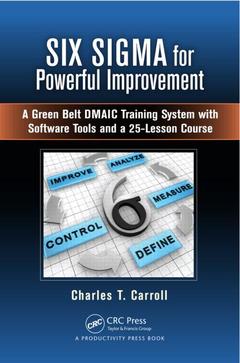Description
Six Sigma for Powerful Improvement
A Green Belt DMAIC Training System with Software Tools and a 25-Lesson Course
Author: Carroll Charles T.
Language: English
Subjects for Six Sigma for Powerful Improvement:
Keywords
Te Ch; CTQ Characteristic; Define Phase Overview; Cycle Time; Tool Training: Voice of the Customer; Subsequent Failure Mode; Measure Phase Overview; CONTROL Retain; Analyze Phase Overview; Risk Priority Number; Improve Phase Overview; Business Process; Validate Measurement System; Quality Function Deployment; CTQ Requirement; Macro Buttons; Dropdown Box; Process Control Plan; Business Case; Develop Team Charter; Da Te; Pareto Chart; Data Collection Plan; MSA; Doe Tool; Implemented Process; Process Performance Objective; Solution Item; Process Members; XXXXXXXXXX XXXXXXXXXX
· 21x28 cm · Hardback
Description
/li>Contents
/li>Readership
/li>Biography
/li>
Although the Six Sigma Define-Measure-Analyze-Improve-Control (DMAIC) methodology is a widely accepted tool for achieving efficient management of all aspects of operations, there are still many unwarranted concerns about its perceived complexity and implementation costs. Dispelling these myths, Six Sigma for Powerful Improvement: A Green Belt DMAIC Training System with Software Tools and a 25-Lesson Course clarifies the long-accepted statistical and logical processes of Six Sigma and provides you with tools you can use again and again in your own "real world" projects?removing any doubts regarding their simplicity and "doability.".
Not only does the book provide you with reasons for using the tools, it reveals the underlying doctrines, formulas, and steps required. Although the tools and techniques presented are specifically associated with the DMAIC philosophy, they are applicable across a wide range of management and improvement scenarios. Explaining Six Sigma processes in language that's easy to understand, the book starts with an overview, followed by specific techniques and procedures. It presents detailed, illustrated lesson segments that include an agenda, roadmap, objectives, and a list of takeaway concepts. It also:
- Provides seven separate Excel tool templates?each with its own user guide and additional smaller tools
- Presents completed Excel sample workbooks for each tool to facilitate your comprehension and utilization confidence
- Includes downloadable resources with a PowerPoint-based DMAIC training course, the aforementioned Excel-based Six Sigma tools and workbooks, and extensive instructor?s notes embedded in each lesson
Trained as and employed as a Black Belt and later as a Master Black Belt, the author presents doctrines and procedures with a strong pedigree and history of success. The book uses hundreds of figures and tables to illustrate key concepts and also makes them available in full-color on the downloadable resources. This is also true of the figures in the user guides that document the accompanying tools. For each of the tools, the book includes a completed sample workbook. The PowerPoint and Excel lessons and tools are provided in both 2007 and 97-2003 versions.
Define Phase: Define Phase Overview. Identify Preliminary Requirements – Step #1. Tool Training: Voice Of The Customer (Voc). Develop Team Charter – Step #2. Define A High Level Process Map – Step #3. Measure Phase: Measure Phase Overview. Select Ctq Characteristics – Step #4. Tool Training: Excel Quality Function Deployment (Qfd) Workbook. Define Performance Standards – Step #5. Tool Training: 7 Process Improvement Tools. Establish Data Collection Plan & Measurement System Analysis (Msa) – Step #6. Analyze Phase: Analyze Phase Overview. Establish Process Capability – Step #7. Define Performance Objectives – Step #8. Identify Sources Of Variation And Waste (Problems) – Step #9. Tool Training: Change Acceptance Management. Tool Training: Project Solution Recommendation Package Tool. Improve Phase: Improve Phase Overview. Experimenting And Piloting – Step #10 (Screen Potential Causes) & Step #11 (Discover Variable Relationships). Confirming Solutions, Setting Tolerances And Documenting – Step #12. Control Phase: Control Phase Overview. Validate Measurement System And Confirm Solution To Management – Step #13. Build Process Control Plan – Step #14. Transfer Solution To Process Owner And Close Project – Step #15. Appendices: Accompanying Compact Disk (Cd) Contents. Glossary. Acronyms And Abbreviations. Dmaic Project Guidelines And Checklists. Example Of A "Lessons Learned" Form Filled Out By A Team Member. Example Of An Administrative Closing Document. Dpmo To Sigma Conversion Table. Distribution Tables. Index.
Charles Carroll is an independent consultant. Initially educated at the U.S. Naval Academy, he later earned an MS in Systems Management at the University of Southern California and served as a Supply, Logistics and Systems Officer in the Marine Corps. He then worked at Sprint Corporation and General Electric’s Employers Reinsurance Corporation (ERC), where he was trained and certified as an internal consultant in GE’s Six Sigma Quality processes,served as a Master Black Belt for the IT Department, administered the local and offshore outsourcing programs, automated project management, and established a global Project Management Office within ERC’s IT department.
Charlie serves as an independent consultant in project/program/PMO management, process improvement, and application development. He has written articles for a number of professional publications, spoken at domestic and international conferences, and developed a number of project management and Six Sigma tools and training for clients. He can be reached at ctcarroll14@sbcglobal.net.
These books may interest you

The Six Sigma Handbook A Complete Guide for Green Belts, Black Belts, and Managers at all Levels 103.28 €

Six Sigma For Dummies 27.33 €


